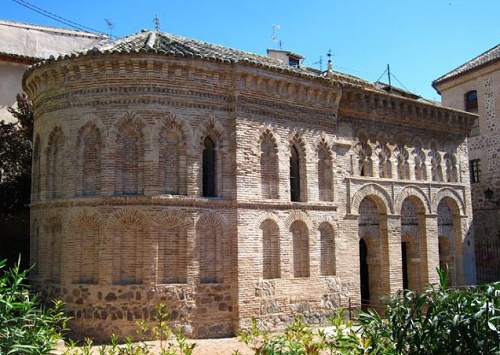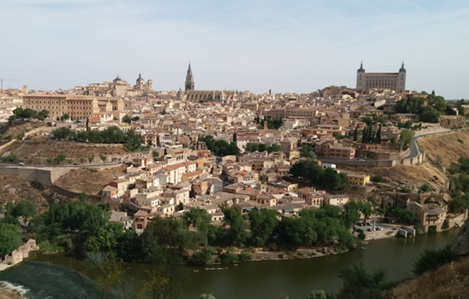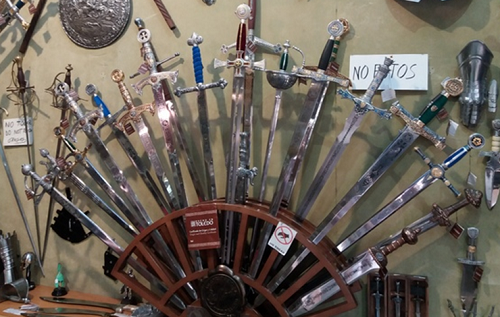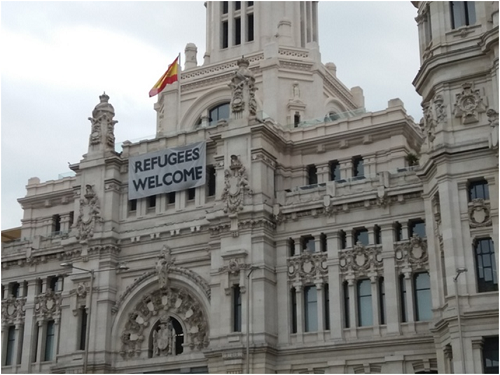“Until disaster struck….”
Fascinating history of Spain, well, all of Europe, and the disastrous consequences of the rise of Islam.
It’s what children in our public schools should be taught under “World History” instead of dawah, the proselytizing for Islam.
HOLY TOLEDO
By Dr. Jack Wheeler, To The Point News, June 2, 2017:Toledo, Spain. As you drive up the hill upon which this ancient city sits, at the city’s entrance you are greeted by this statue. It is of King Alfonso VI of León and Castile (1040-1109) holding his sword as the Christian cross symbolizing his liberating Toledo from Moslem rule.The sword has been the symbol of Toledo for 25 centuries. Celtic blacksmiths who lived on the hill along the Taugus River learned that the minerals in the iron ore of the region was exceptional for forging weapons. They got so good at it that Hannibal equipped his Carthaginians with their swords, enabling them to inflict defeat after defeat on the Romans after his famous crossing of the Alps with elephants in 218 BC.By 193 BC, the Romans located the source of the swords, subjugated the Celts, and founded a city on the hill, naming it Toletum. Roman blacksmiths there developed a process of making swords of layered steel with different carbon contents, known to history as “Toledo steel,” the finest in the world for millennia until the hi-tech methods of today.After Emperor Diocletian began in 285 AD dividing the Roman Empire in two, west and east, and Emperor Constantine completed the process in 324 by founding the Eastern Roman Empire with its capital of Byzantium renamed for him – Constantinople – the Western Roman Empire and its capital of Rome began a long slow deterioration.Huge swaths of Europe were taken by Germanic tribes. One of them, the Visigoths, sacked Rome in 410. They tried to settle in Gaul but were kicked out by the Franks. So they crossed the Pyrenees to create a Kingdom of the Visigoths that encompassed most of present-day Spain – with its capital here at Toledo.Thus the city became Holy Toledo – for the Visigoths became Christians. At first, in the mid-400s, they adapted an interpretation of Christianity known as Arianism. By the 580s they accepted the Roman Catholic or “Nicene” version.What’s important to grasp about the Visigothic Kingdom of Spain, lasting 300 years from the mid-400s to the mid-700s, is that it was a flourishing civilization, with prosperous towns and cities and a vibrant culture. There were no Dark Ages.That is, the “Fall of Rome” – dated at 476 when the “barbarian” (albeit an Arian Christian) Odoacer became the first King of Italy – did not precipitate the “Dark Ages.” Gibbon was wrong. Modern archaeology has unearthed an abundance of evidence that civilization – flourishing Christian civilizations – continued throughout Christian Egypt, the Christian Maghreb (north coast of Africa), Christian Visigothic Spain, and Christian Gaul.Continued, that is, until disaster struck. Starting in the mid-600s in Egypt and the Maghreb, and the mid-700s in Spain, the archaeology vanishes. Countless towns and villages are abandoned and turn to rubble, the same with most all cities. Many never come back. Some take more than 200 years to recover.It is this period, from the mid-600 or 700s to the mid-900s, that saw a spreading and deepening Dark Ages that snuffed civilization out in much of Europe. What caused it?Islam.The Arab Conquest left civilizational wreckage in its wake in Egypt, the Maghreb, then into Spain where the Visigothic Kingdom was destroyed, and then finally stopped in 732 at the Battle of Tours by Charles Martel and his Frankish knights.The book to read on this is The Impact of Islam by historian Emmet Scott.He not only goes through the newest evidence of archaeology, but explains how the worst practices of Medieval Europe were adopted from Islam – such as slavery, which was little practiced in Christian pre-Moslem Spain for example. Christianity ended the horror of Roman slavery on which the Roman Empire depended. Islam brought it back.Further, a principal cause of the poverty of the Dark Ages was Islam’s closing of the Mediterranean trade routes from west to east, isolating and impoverishing the west.Yet even though their kingdom was conquered by Moslem crusaders, the Visigoths were not. One of them, a Christian knight named Pelagius (685-737), led them north into the remote Pico de Europa mountains. It was there he began the centuries-long effort to rid Spain of the Islamic conquest known as the Reconquista.The article to read on this is Reconquista (TTP, August 2009). It recounts one of the greatest heroic epics in the history of Christian Civilization.It was Alfonso VI who liberated Toledo from the Moslems in 1085. It was his great-grandson, Alfonso VIII (1155-1214) who led 30,000 knights in a surprise attack on 200,000 Moslems at the Plains of Tolosa in 1212 to destroy Moslem rule in Spain.Except for one remaining Emirate of Granada in the south. Finally, the emir, Boabdil, surrendered in 1492 to Ferdinand and Isabella, and the Reconquista was complete. Ferdinand and Isabella’s grandson, Charles I of Spain and Holy Roman Emperor Charles V (1500-1558) restored Toledo as Spain’s court and church capital – making the city Holy Toledo again after 800 years.Today, Toledo is a small town of some 50,000, charming, historic, and peaceful. There’s not a burqa in sight. There’s not a mosque in the city. There was a mosque which centuries ago was converted into a church – which reminds everyone of the Reconquista victory by being called Mesquita Cristo de la Luz – Mosque of Christ of the Light:The city vista is stunning – and there are sword stores everywhere:
However – you knew a however was coming – just an hour’s drive to the north lies Spain’s capital of Madrid. The city government has festooned a huge banner across the face of the Madrid City Hall. It is:“The council, run by leftist bloc Ahora Madrid, made the move (to hang the banner) to express its solidarity with the increasing numbers of asylum seekers from countries such as Syria who are desperately trying to enter Western Europe.”The paper says the banner will be left in place for only week. The El Pais story was written in September 2015. As you can see, for I took this picture two days ago, it’s still there.It is such childish stupidity, such suicidal masochism, that is causing The Strange Death of Europe.That’s the title of a just-out book by British author Douglas Murray. It is a historically monumental tragedy what Western Europe is willfully doing to itself.Is there hope? If there is, it could start right here in a Holy Toledo that ignites a New Reconquista – not just for Spain, but a reconquering of all of Europe for Christianity and Western Civilization.Look at that picture of Alfonso VI again, holding high the Sword of Christ and Civilization for all to see. The Christian knights of the Reconquista fought for centuries to liberate their land from heathen invaders.
All the Europeans need is just a small fraction of their courage and indomitable persistence.---http://pamelageller.com/2017/06/toledo-rise-of-islam-destroys.html/




No comments:
Post a Comment